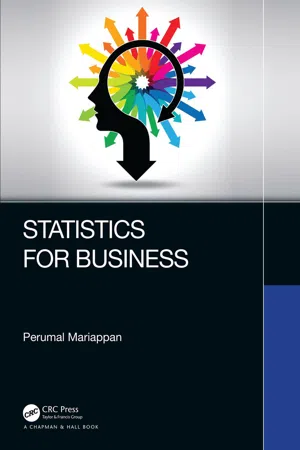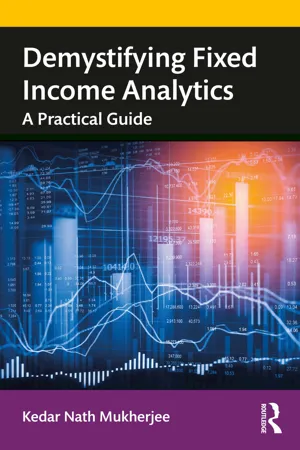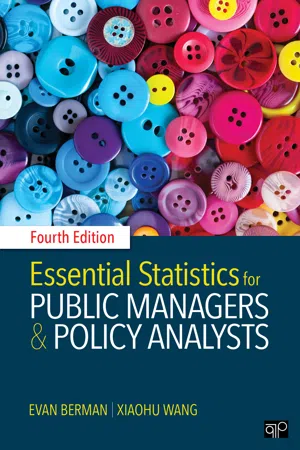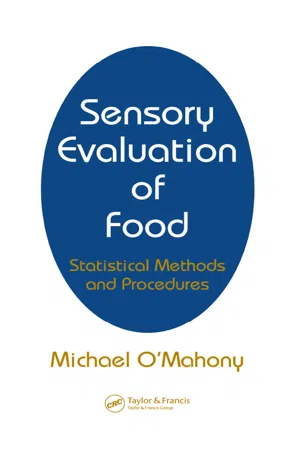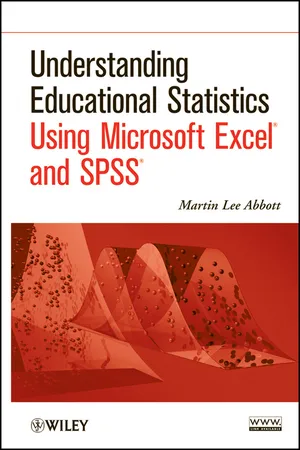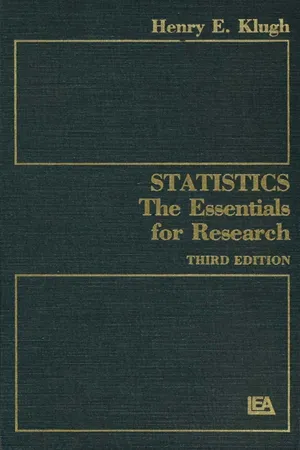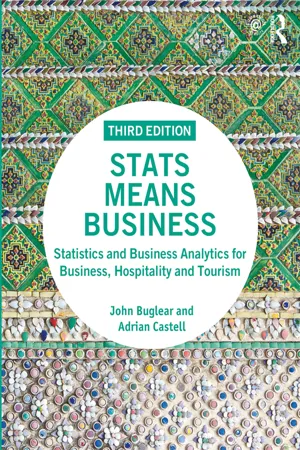Mathematics
Measures of Central Tendency
Measures of central tendency are statistical values that represent the center or average of a data set. The three main measures of central tendency are the mean, median, and mode. The mean is the sum of all values divided by the number of values, the median is the middle value when the data is arranged in ascending order, and the mode is the most frequently occurring value.
Written by Perlego with AI-assistance
Related key terms
11 Key excerpts on "Measures of Central Tendency"
- eBook - ePub
Quantitative Techniques in Business, Management and Finance
A Case-Study Approach
- Umeshkumar Dubey, D P Kothari, G K Awari(Authors)
- 2016(Publication Date)
- Chapman and Hall/CRC(Publisher)
3Measures of Central Tendency
3.1 Introduction
One of the most important objectives of statistical analysis is to get one single value that describes the characteristic of the entire mass of unwieldy data. Such a value is called the central value, or an ‘average’. The word average is very commonly used in day-to-day conversation. For example, we often talk of average students in a class, average height or weight, average income and so forth.The objective here is to find one representative value which can be used to locate and summarise the entire set of varying values. This one value can be used to make many decisions concerning the entire set. We can define Measures of Central Tendency (or location) to find some central value around which the data tend to cluster.3.2 Significance of Measures of Central Tendency
The significance is to get one single value that describes the characteristics of the entire group. The central value is measured by condensing the mass of data into one single value, enabling us to get a bird’s-eye view of the entire data. Thus, one value can represent thousands, lakhs and even millions of values.To facilitate comparison, the central value is measured by reducing the mass of data into one single figure, enable comparisons to be made. Comparison can be made either at time points or over a period of time. For example, we can compare the percentage results of the students of different colleges on a certain examination.Measures of Central Tendency, that is considering the mass of data in one single value, enable us to get an idea of the entire data. For example, it is impossible to remember the individual incomes of millions of earning people of any country. But if the average income is obtained, we get one single value that represents the entire population.Measures of Central Tendency also enable us to compare two or more sets of data to facilitate comparison. For example, the average sales figures of June may be compared with the sales figures of previous months. - eBook - ePub
- Perumal Mariappan(Author)
- 2019(Publication Date)
- Chapman and Hall/CRC(Publisher)
4 Measures of Central Tendency (MCT) 4.1 IntroductionStatistical methods are needed for summarizing and describing the collected numerical data. The main objective of this chapter is to introduce one representative value that can be used to identify and summarize an entire set of data. This representative value is going to be helpful in making decisions based on the data collected. Measures of Central Tendency (MCT) are used to set the central value around which the data are spread over.4.2 MCTThe average of a distribution is its representative size. As most of the items of the series cluster around the average, it is called a ‘measure of central tendency’. The average is computed to reduce the complexity of the data. The entire distribution is reduced to one number, which can be considered typical of an important characteristic of the population, and the same can be used in making comparisons and in examining relations with other distributions.For example, it is not possible to remember the individual’s income in crores of earning people in India. By considering all the data related to income, if the average income is evaluated, we get a single value, which is going to represent the entire population. The commonly used averages are as follows:• Arithmetic mean • Median • Mode • Geometric mean • Harmonic mean 4.2.1 Properties of Best Average It should be • Rigidly defined. • Based on all observations of the series. • Easy to calculate and simple to understand. • Capable of further algebraic treatment. • Free from the extreme values (i.e., it should not be affected by extreme values).The arithmetic mean is ideal in these respects, even though the other averages are also useful in certain specific cases. The median is quite useful for studying data not capable of direct quantitative measurement like skin colour, etc. The measure mode is good when the extreme values are not well defined. - eBook - ePub
Demystifying Fixed Income Analytics
A Practical Guide
- Kedar Nath Mukherjee(Author)
- 2020(Publication Date)
- Routledge India(Publisher)
3 Basic statisticsKey learning outcomesAt the end of this chapter, the readers are expected to be familiar with:- Descriptive statistical measures required to analyze financial market data
- Correlation and regression analysis required to understand and analyze the interrelationship between various segments of financial markets and between financial products.
- Theory of probability and some important probability distributions that some financial data are expected to follow to understand and analyze the statistical behavior of financial products using their historical observations.
- Testing the statistical significance of necessary statistical estimates required to analyze the financial market data.
Measures of Central TendencyA large volume of data in itself is of very little use in arriving at any meaningful conclusions. Therefore, it becomes necessary to obtain a single number to represent a whole mass of data. This single figure would describe an entire series of observations of varying sizes. Such a typical value usually occupies a central position, so that some observations are larger and some smaller than it. There are various measures to convert a huge mass of data into a single representative figure, commonly known as Measures of Central Tendency and include mean, median, and mode.Arithmetic mean/averageArithmetic mean is considered to be the easiest and simplest measure of central tendency that fulfills all the criteria of a satisfactory average measure. This measure is based on all observations and is also easy to calculate. As far as sample fluctuations are concerned, arithmetic mean has been found to be the most stable measure of central tendency. In other words, if many samples are drawn from the same statistical population, arithmetic mean will be found to fluctuate less than any other Measures of Central Tendency.The arithmetic mean of a set of observations is defined as their sum, divided by the number of observations. If X1 , X2 , . . ., Xn are the values of a variable with frequencies f1 , f2 ,. . .. . .., fn - eBook - ePub
Data Analytics
Systems Engineering - Cybersecurity - Project Management
- Christopher Greco(Author)
- 2021(Publication Date)
- Mercury Learning and Information(Publisher)
3 STATISTICS REVIEW – MEASURES OF THE CENTRAL TENDENCYIt is interesting when someone draws a circle. The circle takes a shape, but if the person wants a perfect circle, they should use a protractor and start with a center point to ensure that the area of the circle is the same in all directions. This is the same as the concept of the “central tendency in statistics” (or central tendency). The idea of finding the center of the data, much like having the center of the circle, is the perfect beginning to the analysis of that data. These measures are not only vital to determining the center of the data, but essential for the fundamentals of data science. The first measure of the central tendency that most people have some familiarity with using is the mean, or average. Before delving into this concept, remember back in high school when the teacher was handing out the test results? She may have described the average of the test. This is not only a measure of center, but also a measure of how well the student did in relation to other students. An average or mean is the focal point of many analytic beginnings and should always be considered at the beginning of the analysis because it helps describe the data. Some analysts gloss over the mean as just a forced calculation to get to the more detailed analysis, but in actuality, the mean is probably the best way to determine some basics about the data. For example, in many convenience stores, there is a height chart so that the police can make a quick description of an individual should that individual rob the store. Think of the mean as this chart, a place to quickly observe and describe data now and in the future.3.1 MeanMost people use the mean and do not even realize they are doing so. They prefer using the mean because it is relatively straightforward and gives a quick result. However, and this is important, the mean is impacted by high and low numbers. These very high and low numbers in a dataset are called outliers and are described in a handbook by a federal agency (www.itl.nist.gov/div898/handbook/prc/section1/prc16.htm - Evan M. Berman, XiaoHu Wang(Authors)
- 2016(Publication Date)
- CQ Press(Publisher)
Chapter 6 Central TendencyChapter Objectives
After reading this chapter, you should be able to- Identify three statistics of central tendency
- Calculate the mean, median, and mode
- Know appropriate uses of the mean, median, or mode
- Address problems of missing data
- Know when and how to weight data
- Estimate Measures of Central Tendency from grouped data
The first family of univariate analysis is measures of central tendency, which provide information about the most typical or average value of a variable. Although measures of central tendency are popularly referred to as averages, they are in fact three separate measures: the mean, median, and mode. Analysts frequently use these types of measure when reporting on, for example, high school violence, housing starts, pollution, and the like. Programs and policies often aim to shape the average of something, such as lowering the average amount of some pollution, and even where totals are reported (e.g., total number of housing starts), managers and analysts usually want to know their average over some period as well. This chapter discusses three types of averages and some considerations for using them.Chapters 2 and 3 introduced important research concepts. It is worth reviewing these concepts here, because the discussion that follows illustrates their relevance. Succinctly, variables are key to research and are defined as empirically observable phenomena that vary. High school violence, housing starts, and pollution are examples of empirical phenomena that vary. Management and policy is very much about changing or shaping variables in some way to make society better off. Attributes- eBook - ePub
Sensory Evaluation of Food
Statistical Methods and Procedures
- Michael O'Mahony(Author)
- 2017(Publication Date)
- CRC Press(Publisher)
For the mean to be used, the spread of the numbers needs to be fairly symmetrical; one very large number can unduly influence the mean so that it ceases to be a central value. When this is the case, the median or the mode can be used.The Median
The median is the middle number of a set of numbers arranged in order. To find a median of several numbers, first arrange them in order and then pick out the one in the middle.Example 1 Consider1 2 2Here the number in the middle is 3. That is, the median = 3. Example 2 Consider3 ¯4 7 71 2 3 : 3 3 4Here there is no one middle number, there are two: 3 and 3. The median in this case is the number halfway between the two middle numbers. So the median = 3. Example 3 Consider1 2 2 : 3 8 90Again, there are two middle numbers: 2 and 3. The number halfway between these is 2.5. So the median = 2.5. Note how the extreme value of 90 did not raise the median the way it would have the mean.The Mode
The mode is the most frequently occurring valueExample 4 Find the mode ofThe most commonly occurring number is 7; it occurs four times. So the mode is 7.1 ,1 ,2 ,2 ,3 ,3 ,3 ,4 ,5 ,6 ,7 ¯,7 ¯,7 ¯,7 ¯,8 ,8Of course, it is possible for a set of numbers to have more than one mode, or if no number occurs more than any other, no mode at all. A distribution with two modes is said to be bimodai, three modes, trimodal\ and so on.2.2 Which Measure of Central Tendency Should you Use?
The mean is the most useful statistic when inferences are to be drawn about a population from a sample; the mean of a sample is the best estimate of the mean of the population. It is commonly used by statisticians but is affected unduly by extreme values. The mode is easily computed and interpreted (except where there are several possible modes) but is rarely employed; no common inferential procedure makes use of the mode. The median is a useful descriptive statistic which fits the requirements of clear and effective communication, but it is of only limited use where inferences about population parameters are to be made from a sample. It is less affected by a preponderance of extreme values on one side of a distribution (skew) than the mean, and is to be preferred to the mean in cases where there are extreme values or values of indeterminable magnitude (e.g., when values are too big to be measured on the scale being used). The mean uses more information than either of the other measures, shows less fluctuation over successive samples, and is employed in all classical (parametric: see Section 2.7 - Martin Lee Abbott(Author)
- 2014(Publication Date)
- Wiley(Publisher)
This small example shows that only a few extreme scores can exert quite an influence on the mean value. It also shows that the median value in this circumstance might be the more typical score of all the scores since it stays nearer the center of the group. Researchers should be alert to the presence of extreme scores since they oftentimes strongly affect the measure of central tendency. This is especially true any time the values reflect money, like housing values, household income, and so on.TABLE 5.5Adjusted School PercentagesMode
The mode is the most frequently occurring score in a set of scores. This is the most basic of the Measures of Central Tendency since it can be used with virtually any set of data. Referring to Table 5.4 , you can arrange the scores and discover that 50 is the most frequently occurring score in the set. The mode is a typical score or category since data most often “mass up” around a central point, so it makes sense that the mode, at the greatest point of accumulation in the set, represents the most prevalent score.Central Tendency and Levels of Data. Earlier, I stated that statistics are like tools and the researcher must use the most appropriate tool with the data available for their research. This is true with representing central tendency as well.The mean is used with interval (or ratio) data since it is a mathematical calculation that requires equal intervals. The median and mode can be used with interval as well as “lower levels” of data (i.e., ordinal and nominal), whereas a mean cannot. Using either median or mode with interval data does not require a mathematical calculation; it simply involves rank ordering the values and finding the middle score or the most frequently occurring score, respectively. The mean cannot be used with ordinal or nominal data since we cannot use mathematical calculations involving addition, subtraction, multiplication, and division on these data, as I discussed above.The median is a better indicator of central tendency than the mean with “skewed” or imbalanced distributions. We will have more to say shortly about skewed sets of scores, but for now we should recognize that a set of scores can contain extreme scores that might result in the mean being unfairly influenced and therefore not being the most representative measure of central tendency. Table 5.5- William P. Fox, Rodney X. Sturdivant(Authors)
- 2022(Publication Date)
- Chapman and Hall/CRC(Publisher)
3Statistical MeasuresDOI: 10.1201/9781003317906-3Objectives
- Learn how to use R to obtain and interpret descriptive statistics for the center (location), spread, and shape of the distribution of a data set.
- Learn how to use R to obtain displays and be able to interpret them.
- Know what the measures are and which ones are used for quantitative data and which ones are better for qualitative data.
3.1 Measures of Central Tendency or Location
3.1.1 Describing the Data
In addition to plots and tables, numerical descriptors are often used to summarize data. Three numerical descriptors, the mean, the median, and the mode, offer different ways to describe and compare data sets. These are generally known as the measures of location.3.1.2 The Mean
The mean is the arithmetic average, with which you are probably very familiar. For example, your academic average in a course is generally the arithmetic average of your graded work. The mean of a data set is found by summing all the data and dividing this sum by the number of data elements.The following data represent 10 scores earned by a student in a college mathematics course: 55, 75, 92, 83, 99, 62, 77, 89, 91, 72. We find the mean in the same way you would compute the student’s average. The mean can be found by summing. We first sum the 10 scores:55 + 75 + 92 + 83 + 99 + 62 + 77 + 89 + 91 + 72 = 795and then divide by the number of data elements (10), 795/10 = 79.5.To describe this process in general, we can represent each data element by a letter with a numerical subscript. Thus, for a class of n tests, the scores can be represented by a1 , a2 , …, an . The mean of these n values of a1 , a2 , …, an is found by adding these values and then dividing this sum by n- eBook - ePub
- Perry R. Hinton(Author)
- 2014(Publication Date)
- Routledge(Publisher)
Figure 2.1 . Even though there is a clustering of the marks in the 50s the mode would be zero. In this case the mode would be a poor measure of central tendency.The score which has occurred the highest number of times in a set of data.modeAnother measure of central tendency that is used more often than the mode is themedian. This is the score that comes in the middle of the list when we have ordered it from lowest to highest. If we had nine students in all then the median would be the fifth mark in the list. However, we have one hundred students and, with an even number, there is no middle mark. The middle lies halfway between the fiftieth and fifty-first marks. In our example the fiftieth and fifty-first marks are both 54, so the median is 54. (If the fiftieth and fifty-first marks had been different the median would be halfway between them. We would simply add them up and divide by two to get our median value.1 )If we order a set of data from lowest to highest the median is the point that divides the scores into two, with half the scores below and half above the median.medianThe median is a good measure of central tendency as it picks up the score in the middle position of the distribution. Its weakness, if indeed it is a weakness, is that, like the mode, it does not use all the information given by the marks. The median is simply the score where we cut our list into two halves. The marks either side of the median could be anything below or above the median respectively. If we found that someone who had been given a mark of 9 in the examination really had a mark of 29 or 39, correcting this score would not change the median as 54 would still be the middle mark in the list. The median would stay the same even if a number of marks were changed (as long as a mark below the median was not changed to a value higher than the median or vice versa). The median doesn’t take account of the values of all the scores, only the value of the score at the middle position. - eBook - ePub
Statistics
The Essentials for Research
- Henry E. Klugh(Author)
- 2013(Publication Date)
- Psychology Press(Publisher)
We are not concerned with how far a score is above or below this point. Except for the score or scores that locate the median (the N /2 score), the actual size of all other scores play no part in its calculation. We could, in fact, calculate a median for a distribution of scores even if the top score were partially illegible. We would only need to be certain that it was above the interval containing the median. The mean is quite different, Σ X is affected by any change in the value of any score. If μ = Σ X/N, any error or change in the value of a score will change Σ X and consequently change the mean. Notice that 2, 4, 6, 8, and 10 as well as 2, 4, 6, 8, and 100 have the same median (6), but quite different means. You now know three ways to describe the central tendency of distributions: modes, means, or medians. The mean is usually preferable as a measure of central tendency, and it forms the basis for more advanced statistical treatments. On the other hand, if the data are badly skewed, the mean will be a very misleading description of central tendency and we might prefer to use the median. 3.12 Review Distributions can differ in a variety of ways. They can differ in size, indicated by N, the number of measurements on which they are based. They can differ in central tendency, measured by the mean, the sum of all measures divided by their number; or by the median, the middle score in a distribution. They can differ in skewness, with positively skewed distributions having the “tail” to the right or high end of the continuum, negatively skewed distributions having the “tail” toward the left, or low end of the continuum. Distributions with zero skew are symmetrical. Calculation of centile points other than the median was explained, as was the determination of centile ranks - eBook - ePub
Stats Means Business
Statistics and Business Analytics for Business, Hospitality and Tourism
- John Buglear(Author)
- 2019(Publication Date)
- Routledge(Publisher)
descriptive measures. These summary measures are very effective and widely used methods of communicating the essence or gist of a set of observations in just one or two figures, particularly when it is important to compare two or more distributions. Knowing how to interpret them and when to use them will help you become a much more effective communicator and user of statistical information.There are two basic ways of summarising a set of data. The first is to use a figure to give some idea of what the values within a set of data are like. This is the idea of an average, something you are probably familiar with; you may have achieved an average mark, you may be of average build and so forth.The word average suggests a ‘middle’ or ‘typical’ level. An average is a representative figure that summarises a whole set of numbers in a single figure. There are two other names for averages that you will meet. The first is measures of location, used because averages tell us where the data are positioned or located on the numerical scale, so they measure the location of the data. The second is Measures of Central Tendency, used because averages provide us with some idea of the centre or middle of a set of data.The second basic way of summarising a set of data is to measure how widely the figures are spread out or dispersed. Summary measures that do this are therefore known as measures of spread or measures of dispersion. They are single figures that tell us how broadly a set of observations is scattered.These two types of summary measures, measures of location and measures of spread, are not alternatives; they are complementary to each other. That is, we don’t use either a measure of location or a measure of spread to summarise a set of data. Typically we use both a measure of location and a measure of spread to convey an overall impression of a set of data, in the same way that suspects in a police drama on television might be described by both their height and their weight.3.2 Measures of location
There are various averages, or measures of location, that you can use to summarise or describe a set of data. The simplest both to apply and to interpret is the mode.
Index pages curate the most relevant extracts from our library of academic textbooks. They’ve been created using an in-house natural language model (NLM), each adding context and meaning to key research topics.

